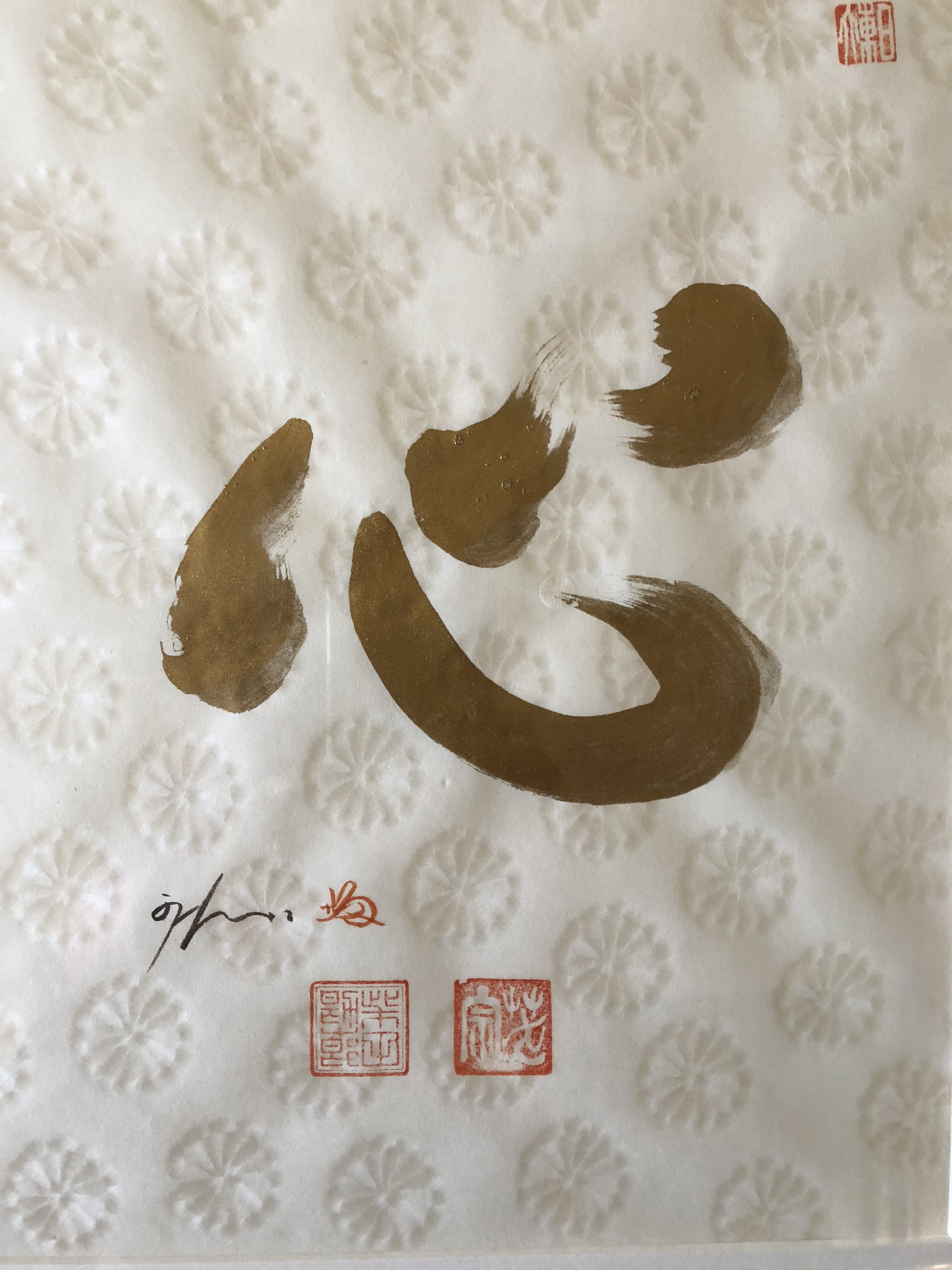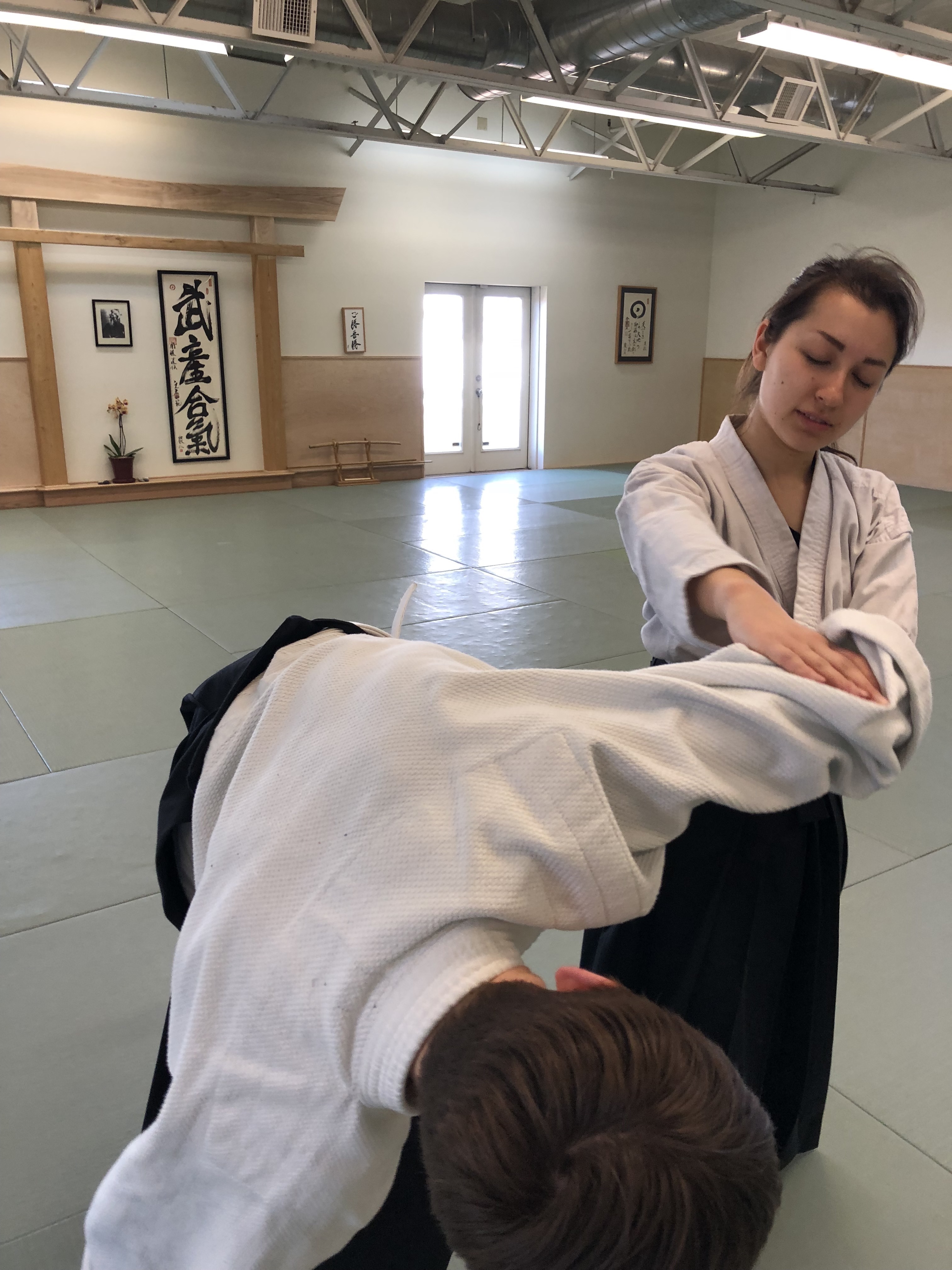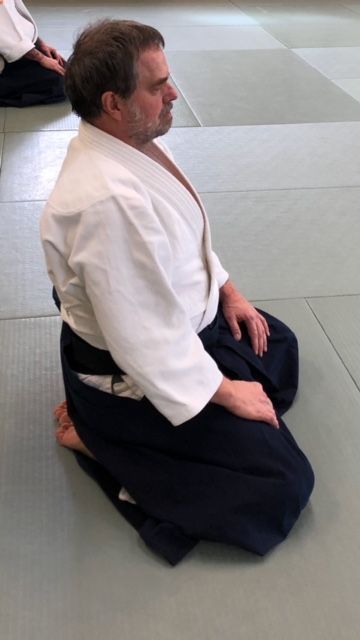by Ania Small Ph.D.
Sometimes the biggest breakthroughs in Aikido come from attitude shifts. We can reach deeper understanding through emotionally transformative practice. Altering how we picture the movement can dramatically change it’s physical manifestation. This article explores how the mind can promote or get in the way of progress. It looks at mental strategies for learning, effective teaching and class and test preparation.
Aikido is not a sport and has no competitions, which makes it well suited to working on the practice itself, rather than it’s outcome. Sports Psychologists encourage athletes to do exactly that, emphasizing “being in the zone” for reaching “optimal performance”. Aikido’s focus on the process lends itself to mental strategies promoting it’s principles and philosophy. If we can be aware of our mind’s role in our practice, we can use that knowledge to deepen our understanding of the art.
I am not advocating “more thinking”, but rather recognizing what’s in our mind already, to decide what helps our practice and what doesn’t. I’m suggesting being more insightful as well as intentional with our thoughts, attitudes and feelings. “Getting out of our head” doesn’t mean ignoring what goes on in it. It simply means not letting it interfere with the present focus of practice. There is a great power in knowing how to use our mind, the same way we work on our body.

Kokoro: Mind-Heart-Spirit
Thoughts and attitudes and their role in developing Aikido movement:

Thoughts
Shifting our thinking about technique can affect the execution of it, and eventually the feeling of interaction between partners. If I conceptualize ikkyo as twisting my partner’s arm to force them down, it will result in physical struggle and a feeling of conflict. In contrast, seeing cutting the arc as an opportunity to organize one’s own body, and connect with uke can align better with Aikido principles.
One of the thoughts that often gets in a way of progress is that we need to win. It’s so ingrained that even though we know Aikido is not a competition, we still view interactions on the mat through the glasses of success and failure. Focusing on the success of the technique, manifested in throwing our partner can get us off balance, and reduce our ability to take in new information and adapt. It makes it difficult to be fully present and keep the integrity of our own body.
Some of the work on thoughts can be done outside of class. But even when we feel threatened or stressed, present focus and relaxation during practice, alongside a new narrative can help us get better. For example focusing on entering as opposed to avoiding getting hit, is a quick shift in a way of thinking about a technique, and can be helpful in improving irimi movement.
Although it would be difficult to cover all thoughts facilitating progress, and sustained practice, there is one that can be particularly helpful. It comes from a theory of “Positive Disintegration”, developed by Polish psychologist, Kazimierz Dabrowski. It applies to times when it seems, like what you knew doesn’t work anymore, and practice feels frustrating. In the language of “Positive Disintegration” theory, it’s a natural part of progress, when the old knowledge falls apart, creating impetus for new insight. Applying that framework could help see it in positive terms, and to avoid unnecessary frustration, potentially leading to quitting Aikido. Thinking “the old insight fell apart to make room for new learning” is a more adaptive way of approaching it.
Attitudes:
Attitudes, which are settled ways of thinking reflected in behavior, are a little bit harder to change. They play an important role in how we act, what kind of energy we project, and the impact we have on others. Our Aikido practice reflects the way we see things. Increasing awareness of our settled ways of thinking can help develop attitudes promoting progress. Practicing Aikido gives us an opportunity to peel the layers, and confront issues that get in our way. Whether it happens gradually or through sudden insight, we can take an active role promoting attitudes that help us grow.
Sports Psychologist JoAnn Dahloetter, in her book “Peak Performance”, talks about two kinds of attitudes that facilitate progress. The first category includes determination, discipline, commitment, sacrifice, mental toughness and positive mental attitude. The second is comprised of what she calls “softer qualities of patience, humility, expression of feelings, faith in your plan, belief in yourself, accepting responsibility, and sense of enjoyment”. All of those are incredibly important in Aikido training, and finding the right balance between pushing ourselves and accepting helps us get better.
Difference in attitudes might decide who will stick with training. If your goal is getting a black belt, you might quit soon after thinking you’ve learned everything there is to learn. On the other side of the spectrum, is an attitude of “I’m not good at this”, undermining our own progress. Neither way helps with development and sustaining the practice. In her book “Mindset”, Carol Dweck talks about different attitudes towards learning. Both of the above examples describe, what she calls a “fixed mindset.” The other kind, which she calls “growth mindset” is a belief that most basic abilities can be developed through dedication and hard work, and learning is ongoing.
Mitsugi Saotome Sensei emphasizes the harder and softer attitudes that promote learning in Aikido. He talks about maintaining martial presence in Aikido class, as if being on a battlefield. That kind of attitude emphasizes the sharpness of focus and present orientation. It could be compared the “performing edge” experience, described by athletes. Maintaining such attitude while training, can be very helpful in developing Aikido movement. Saotome Sensei also emphasizes “beginner’s mind”, a quality of openness to new learning, and new situations, allowing for ability to adapt. He tells his students “I’m watching you and learning from you. You are my teachers too.” That’s an attitude that allows continued growth.
Feelings and progress:
Feelings can be defined as conscious subjective experience of emotion. They are also described as physical sensation of touch. Both have a big impact on our practice. Our emotions will affect how we physically feel to others, influencing interactions on the mat. Partners can most of the time sense if we are frustrated, afraid or angry. Recognizing our emotions and channelling them appropriately can help us engage in the moment and transform the feelings we entered the dojo with. Aikido practice can be purifying and cathartic. By fully engaging in the energy of movement, we can transform our feelings and manifest a deeper understanding of the art.
Feelings of hunger, desire and love for the art are essential to progress. They push us to get better, to go to class even though it’s not easy, or we feel frustrated. They give joy, and help us feel better after class then we felt heading to the dojo. We can share them with our Aikido friends. Nurturing them in ourselves and our students motivates us to get better. The experience of athleticism and skills development is another feeling instrumental in Aikido progress. Developing physical skills in Aikido is very rewarding to beginners, and important to cultivate it at different stages of practice.
Psychologist Mihaly Csikszentmihalyi coined the term “flow” to describe a feeling of complete absorption in what we’re doing. It’s both physical and psychological experience, and it is essential to Aikido training. It’s a feeling of being present, energized but calm, being in charge of time and having a sense of total mind-body wellbeing. Even though we don’t experience it all the time, the moments when we do, keep us coming for more.
THE POWER OF IMAGERY IN DEVELOPING AIKIDO MOVEMENT:
souzoryoku power of imagination
Saotome Sensei talks about “designing space”, referring to using the mind to create a path followed by the body. Imagery is a powerful tool. We can use it to deepen our understanding of techniques and Aikido principles. Sometimes metaphors and visualizations can help us reach another level, in a way that other instruction can’t. They can cut trough habits of thinking or paradigms to transmit a new way of experiencing Aikido. I recall several situations when an image really helped me grasp something new, that I wouldn’t understand otherwise. William Gleason Sensei, in his article “Creating Image in Aikido” says: the “image enables us to see beyond the obvious visible form of the technique and into the invisible form and feeling of the realm of mind and ki.”
Another way imagery can be used is to motivate. Depending on our goals, we can create visualizations of speed, power, flow, and beauty of the movement. We can imagine ourselves in the future, moving like our favorite teacher. One of the students at our dojo works as a mailman. He doesn’t get to class very often, so after his beautiful test, I asked him how he did it. He responded that he visualizes Aikido movement as he delivers mail.
Although I’m using the term “imagery”, it doesn’t necessarily have to be a picture. It might be one for people who are primarily visual, but others might focus on it’s kinesthetic aspects, or the verbal description. For example, if you use an image of a waterfall to help with relaxation, some will see a waterfall, and others feel what it would be like to stand underneath it. There will also be a few who will mostly relate to the concept of it. It’s important to know how you learn, and to take advantage of that knowledge.
IMPLICATIONS FOR TRAINING AND TEACHING:
Preparing for class:
Successful athletes do a frequent “body scan”, to assess the level of relaxation and readiness. A lot of Aikido students do it as well, and find it very important to training. It could be simply noticing areas that hold more tension, or pain, or going a step further, using breath to create relaxation. “Mind scan” to notice thoughts and feelings in the moment. is equally beneficial. JoAnn Dahlkoetter talks about mental preparation as an equivalent of stretching before a workout. Being aware of your thoughts and feelings before and during class can provide helpful information to better your practice.
Setting aside a time at home, or using the drive or walk to class for mental preparation could help us get in touch with our thoughts, feelings and attitudes. It could also allow to set some goals, visualize how we want to accomplish them, and practice present focus. Dojo’ rituals, like bowing when entering the practice space, as well as at the beginning of class allow extra opportunity for getting mentally ready for class, and creating present focus.
Psychological preparation can help deal with an injury. Do we see it as an obstacle, or an opportunity. Mentally preparing for class can help us reevaluate it, and see if there is a way to use it our advantage, or at least reinterpret the meaning of it. We can decide how much pushing ourselves through it is helpful, and what can be seen as not damaging to our body,“good pain”.

Sports psychologists tell athletes is to “take advantage”of different situations, thoughts and feelings. If you are running, and someone passes you, use their speed to improve your time. Find ways you can use different training environments and circumstances, even injuries to your advantage. It seems that anger and fear are the feelings that show up most frequently on the mat. Taking advantage of the energy of anger and fear in a positive way could be transformative. Using anger and frustration for movement, speed or intensity of the interaction can help the focus and be cathartic. So can working with fear, and instead of holding back, engaging it’s energy to move, staying connected with our partner while protecting our joints.
Preparing for a test:
Preparing for a test, should involve goal-setting, in addition to practicing Aikido techniques and principles. It’s important to be aware of long term goals for practice, as well as goals specific to the test. In addition to deciding on a goal, we can break it down into smaller, manageable pieces (chunking goals), and focus only on one portion at a time.
Another technique that can be used for test preparation is positive images. If your goal for the test is to demonstrate flow, create images in your mind of fluid movement for each technique and for the entire test. Another example of a positive image is creating a sense of expansion up and down, forward and back etc.
Using power words is another strategy that can be very helpful with testing. Sometimes it helps to focus on one thing rather than get lost in details. The words could be related to your goals for the test. They could be simple directives for the movement, like “enter”, or represent the feeling you try to convey, like “calm”, or “expand.”
Maintaining present focus is also important, helping with adapting to the demands of the situation and with staying calm. A meditation before the test, or simply giving yourself verbal instruction to stay in the present can help a lot with ability to respond to challenge in the moment.
Imagining overcoming a difficulty can also be incredibly helpful. For example visualizing continuing a test calmly after getting hit, allows confidence to recover even after the “worst-case scenario”. In addition to being empowering, it can help take advantage of the fear in order to create a positive outcome.
Implications for effective teaching:
Teachers, similar to students, can benefit from awareness of their own thoughts, attitudes and feelings and how they affect practice. Examining what we project on students, and how it affects our teaching can be incredibly beneficial. Encouraging and modeling introspection is an important part of effective teaching. Do we foster both soft and hard attitudes in ourselves and our students to both push and be kind to themselves and their bodies? Finding a balance of challenge and acceptance can help people continue their practice and grow.
Another important role that teachers play is encouraging students to celebrate and enjoy the movement. Finding a balance of movement and explanation seems very important. It’s essential for teachers to cultivate the love for Aikido movement and to transmit it to students. On the other hand, it’s also important to present the big picture, including philosophy and Aikido principles, in order to encourage goal setting beyond learning techniques. That’s what makes the art transformative, and keeps students engaged for a long time.
We all vary in how we process information. Finding a right balance of description, images, and kinesthetic input in class is important. Mixing all three while teaching increases the likelihood of reaching different learners. Knowing your own as well as your students’ preferred ways of processing, can also help teaching effectiveness.
Fostering present focus in class is crucial for teaching effectiveness. It’s not difficult most of the time, since Aikido students tend to be into what they are doing, but it’s essential for teachers to pay attention in the moment. We should always ask ourselves if how we teach serves the class and it’s focus.
Thanks for reading. I’d like to thank Gary Small for listening to my ideas, Julie Tolen and Meghan Reedy for their help with editing, and Josh Drachman for suggesting Japanese kanji that fits the topic. I would love to hear your thoughts and comments.
Ania teaches at Aikido of Maine and is a Counseling Psychologist in private practice


A very nice article by Ania sensei. I find particularly helpful the practical suggestions for mind- and body-scanning before class, and cultivation of both “hard” and “soft” mental attitudes to help us progress. Without critical mental / spiritual self-examination and change, then Aikido loses its value as a “michi” art, and degrades into a purely physical activity; however, much of our heritage in Aikido is to be given spiritual aspirations and goals by our Founder (“reconcile all humanity”) without having any actual tools in our toolbox. I know I will take a little extra time in teaching to add some mind-and body-scanning components to my classes.
I also find it gratifying that the official ASU “yudansha test prep handbook” that compiled the best advice of the organization’s senior teachers included some of the same test-preparation tips that you provide. Well worth considering!
Thanks for writing this!
Thanks Guy, I always value your feedback! Ania